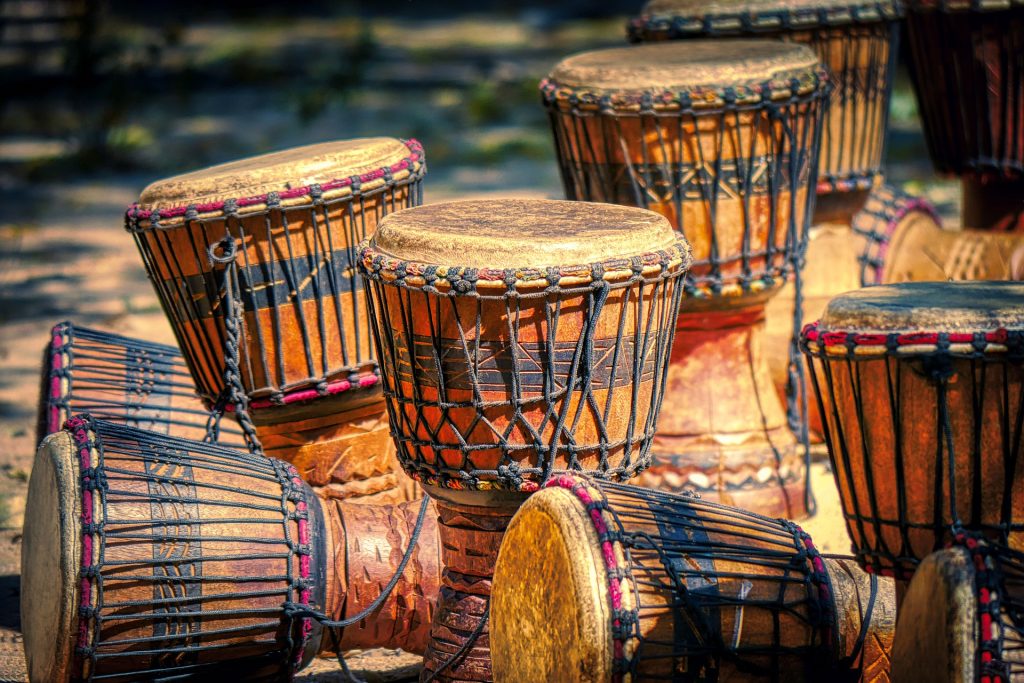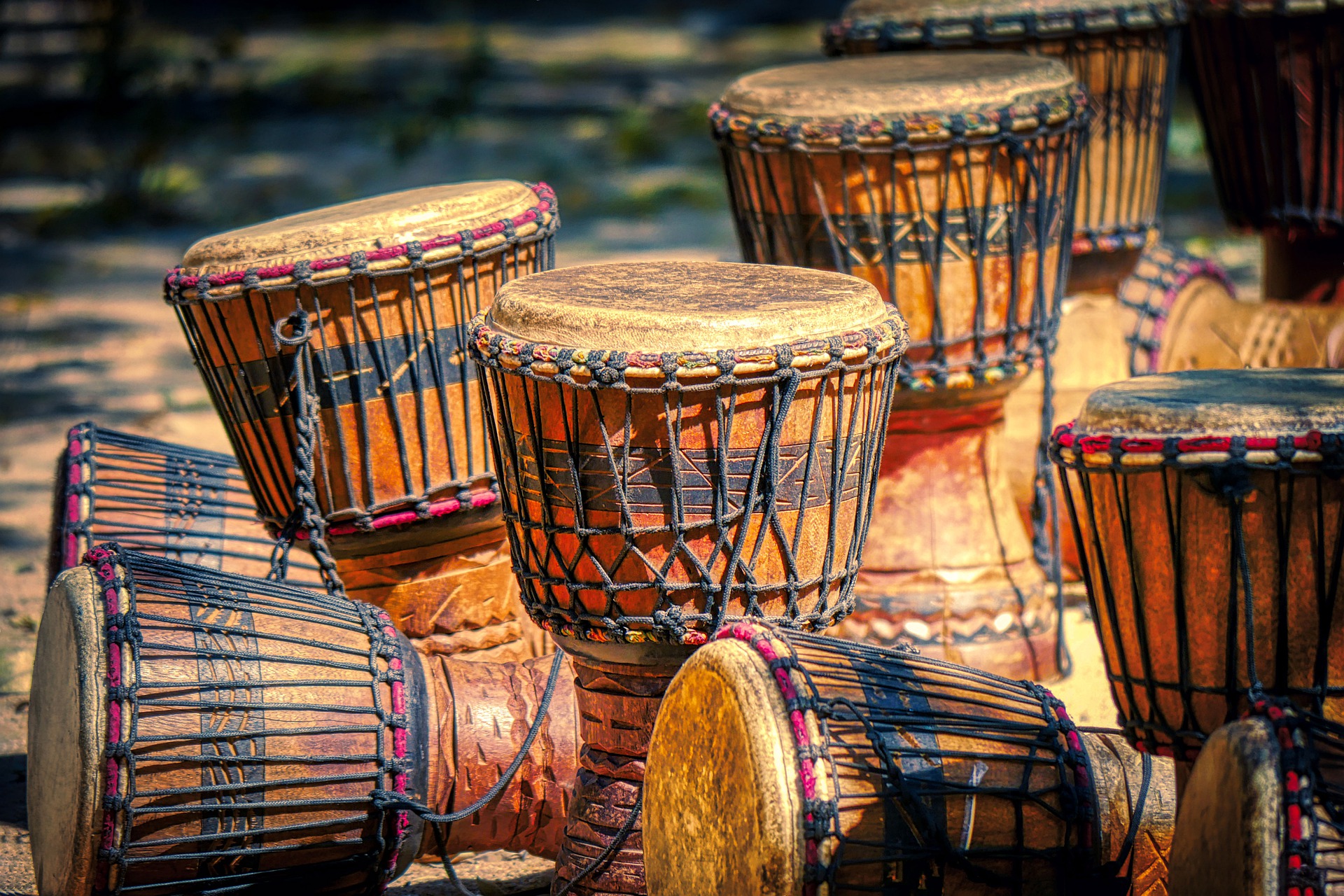
It is well known that African music has seen frequent and significant changes over the ages. Traditional music now is most likely considerably different from African music in the past. Neither has African music always been strictly associated with distinct ethnic groupings. Individual musicians, their styles, and their originality have always been significant.
Archaeological and other objects, pictorial sources (rock paintings, petroglyphs, book illustrations, drawings, paintings), oral historical sources, written sources (travelers’ accounts, field notes, inscriptions in Arabic and in African and European languages), musical notations, sound recordings, photographs and motion pictures, and videotape are all material sources for the study of African music history.
Sub-Saharan African musical styles spread into North Africa in antiquity. Climate change in the Sahara, with a pronounced wet tendency between 8000 and 3000 BC, spread the savanna vegetation and wildlife into the southern Sahara and its central highlands.
The “Green Sahara” cultures left behind a huge gallery of iconographic documentation in the form of rock drawings, among which are some of the first internal sources on African music. One is a vibrant dance scene found in 1956 by French ethnologist Henri Lhote in Algeria’s Tassili-n-Ajjer plateau. This picture, which is stylistically attributed to the Saharan period of the Neolithic hunters (c. 6000–4000 BC), is perhaps one of Africa’s oldest known testimony to music and dancing. The body decoration and movement style are similar to those found in many African civilizations.
Archaeological finds are among the earliest sources of African music. Although musical instruments built of vegetal materials have not survived in the deposits of Sub-Saharan climatic zones, depictions of musical instruments on stone or terra-cotta from Ife, Yorubaland, have provided archaeological source material on Nigerian music. These portrayals are very similar to conventional narratives of their beginnings. Igbn drums (a set of footed cylindrical drums) appear to have been utilized from the 10th to the 14th century AD. The dùndn pressure drum, today linked with Yoruba culture and recognized throughout the savanna region, may have been introduced around the 15th century, as it appears on plaques manufactured around that time period in the kingdom of Benin. Yoruba dùndn drums are now used to accompany oriki (praise name) poetry as “talking drums” (see Oral traditions). The talking drum appears to have come before the twin iron clapperless bell. By the 15th century, pellet bells and tubular bells with clappers were common.
Other music-related archaeological findings include iron bells discovered in the Katanga (Shaba) area of Congo (Kinshasa) and at many sites in Zimbabwe. Because musical instruments such as horns, bells, drums, and even bow lutes are frequently shown on Benin bronze plaques in ceremonial situations, they constitute an additional, nearly limitless source for music history.
Accounts by 14th-century Arab travelers Ibn Baah and Ibn Khaldn, as well as European navigators and explorers Vasco da Gama, Jan Huyghen van Linschoten, Joo dos Santos, François Froger, and Peter Kolbe, are among the most important textual sources. T.E. Bowdich (1819) attempted to notate African music for Ghana, Karl Mauch (1872) for Zimbabwe, and Brito Capelo and Roberto Ivens (1882) for interior Angola.
African peoples’ major and small migrations introduced musical traditions and instruments to new locations. The single and double iron bells, which are thought to have originated in Kwa-speaking West Africa, migrated to western Central Africa with Iron Age Bantu-speaking peoples and then to Zimbabwe and the Zambezi River region. The iron bells and the temporal patterns linked with them were unknown to earlier migratory populations travelling eastward from eastern Nigeria and central Cameroon to the East African lakes. As a result, before the recent advent of Congolese electric guitar-based music’s temporal patterns, these features were lacking in East African music. The zeze (or sese) flatbar zither, a stringed instrument long known along the East African coast, expanded into the interior to Zambia, the eastern part of Congo (Kinshasa), and Malai as the ivory and slave markets intensified throughout the nineteenth century.
Lamellaphones with iron keys, a notable component of ancient Zimbabwe and surrounding kingdoms and chieftainships, moved from the Zambezi valley north to the kingdoms of Kazembe and Lunda, as well as to the Katangan and Angolan civilizations, beginning in the 17th and 18th centuries. Some models shrank as they were used as travel instruments during migration; others were changed, giving rise to the multiple variants found in western Central Africa during the first half of the twentieth century. (See Idiophones for a more detailed description of the lamellaphone.)
In Congo, a small box-resonated lamellaphone known as the likembe went in the other way, from west to east, northeast, and southeast. It was presumably created in the lower Congo area in the mid-nineteenth century, and it expanded upriver with Lingala-speaking porters and colonial employees to the northern Bantu borderland. The likembe was adopted by the Zande, Ngbandi, and Gbaya, who speak Adamawa-Ubangi languages.
Likembe music’s stylistic elements that linked it to its place of origin were only gradually updated in other regions to fit local trends. The likembe distribution region expanded farther to the northeast into Uganda around the turn of the twentieth century, when it was adopted by the Nilotic Alur, Acholi, and Lango. Later, northern Ugandan laborers brought it to southern Uganda, where the Bantu-speaking Soga and Gwere embraced it and proceeded to build replicas completely of metal, even with a metal resonator. The likembe migrated southward from the lower Congo, reaching Angola from the Congo’s Kasai area and being adopted as late as the 1950s by the Khoisan-speaking!Kung of Kwando Kubango province in southern Angola.
Specific characteristics of African music sometimes exhibit a perplexing distribution as a result of migrations and the exchange of musical styles both inside Africa and with foreign civilizations. Extremely remote locations of Africa may have qualities that are similar, if not identical, while close places may have very different styles. The Baule of Côte d’Ivoire’s multipart singing style in triads within an equiheptatonic tone system is so similar, if not identical, to the part-singing style of the Ngangela, Chokwe, and Luvale peoples of eastern Angola that informants from both cultures quickly detect the connection. The reason behind this is a mystery. Several nations with varied approaches to multipart singing split the two regions. Another historical mystery is the presence of almost similar xylophone playing skills and instruments among Makonde and Makua-speaking peoples of northern Mozambique, as well as some peoples of Côte d’Ivoire and Liberia, particularly the Baule and the Kru. The Baule jomolo and the log xylophones of northern Mozambique, such as the Makonde dimbila or the Shirima mangwilo, are almost similar instruments.
To answer such puzzles, numerous diffusionist theories have been proposed. A.M. Jones, an English ethnomusicologist, argued that in the early centuries AD, Indonesian settlers in some parts of East, Central, and West Africa might have imported xylophones and certain tonal-harmonic systems (equipentatonic, equiheptatonic, and pelog scales) into Africa. Ethnohistorians, on the other hand, have emphasized the importance of coastal navigation (the transportation of hired or coerced African labor aboard European ships) as a means of cultural interaction between Mozambique, Angola, and the West African coast.
There are more historical materials on African music and dance than one may imagine. Historical data can often be gathered indirectly through contemporary observation outside of Africa, particularly in Latin America. People taken as slaves from Africa to the New World were more frequently than not from the hinterlands of the African coastal districts. Between the European slave traffickers on the coast and the interior there were buffer zones inhabited by African “merchant tribes,” such as the Ovimbundu of Angola, who are still remembered as vimbali, or Portuguese collaborators, by eastern Angolan peoples. The interior portions of Angola were not immediately accessible to Europeans in the 18th and 19th centuries. However, European observers noticed African prisoners playing musical instruments in New World countries, which opened up access to their music and dance. In Brazil, for example, the music of the Candomblé religion can be directly related to Yoruba orisha worship in the 18th and 19th centuries. Similarly, Umbanda religious rites are an outgrowth of traditional healing sessions still conducted in Angola, while vodun sacred music among the Fon of Benin has ramifications in Haitian and other Caribbean voodoo. The Central African friction drum and the lamellaphone are two examples of African instruments that have been adapted and occasionally further developed in the New World (in the Cuban marimbula).
African music as it is known today was also affected by changes in the continent’s ecosystem, which forced people to migrate to different regions, causing changes in their art. When the Sahara dries up, for example, inhabitants tend to migrate southward. When established people welcomed the intruders, they frequently adopted their musical styles. Thus, the Masai choral singing style had a significant impact on the vocal music of the Gogo in central Tanzania, as seen by their nindo and msunyunho chants.
Scholarly attention has only lately concentrated on the different urban popular forms that have arisen in the last 50 years or more, reflecting a combination of native and foreign influences. The most well-known are West African “highlife,” Congolese dance music, East African tarabu, and South African traditions. Since the increasing embrace of Christianity in Africa in the nineteenth century, numerous new types of African church music have emerged and continue to flourish. Hymns, as well as secular music, are frequently modified as protest songs with altered lyrics in order to raise resistance against political tyranny. A synopsis of African music history.








